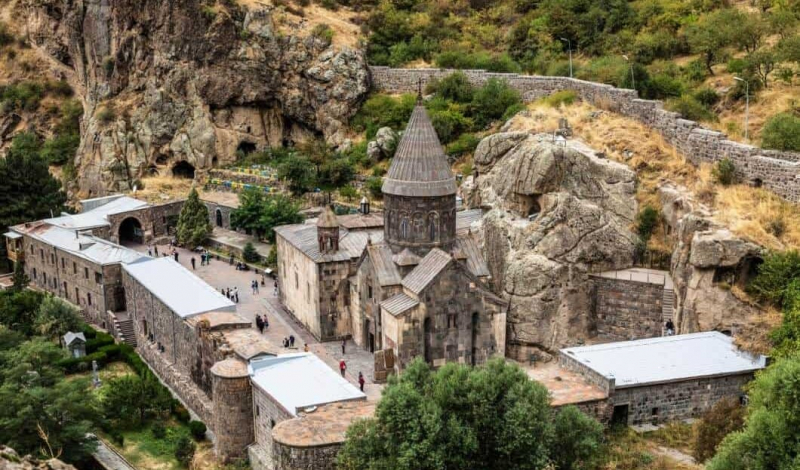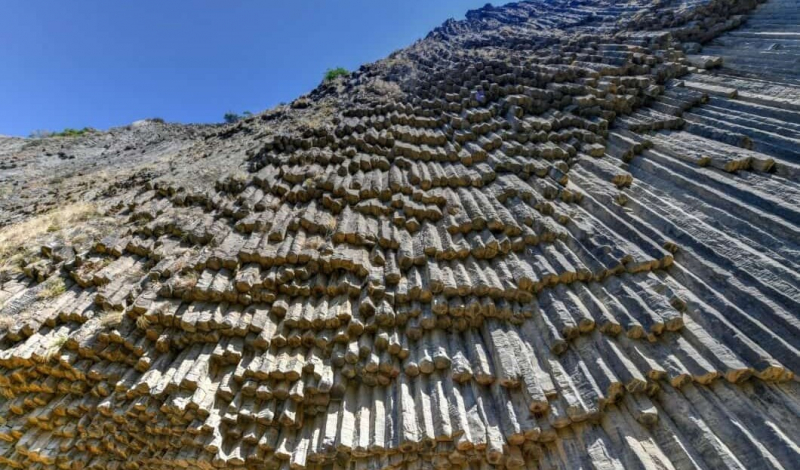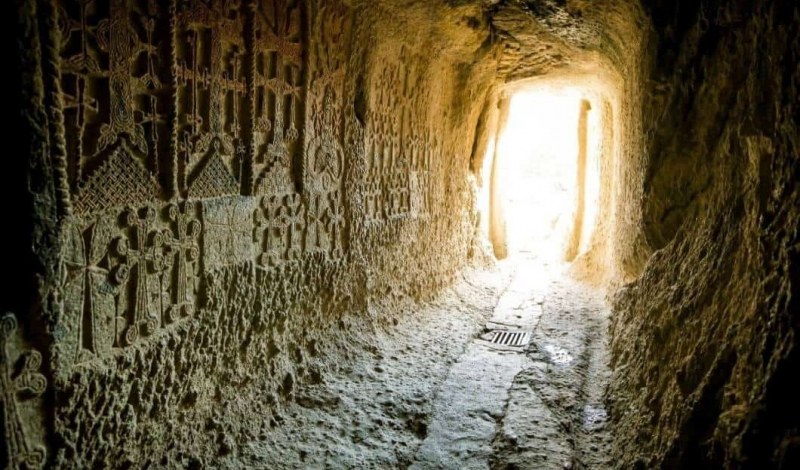Contents
- 1 Khor Virap Monastery: A Pilgrim’s Vista to the Soul of Armenia
- 2 Geghard Monastery and Garni Temple: Echoes of Rock and Ritual
- 3 Symphony of Stones: Nature’s Volcanic Symphony in Basalt
- 4 Lake Sevan and Sevanavank: The Azure Heart of the Highlands
- 5 Tatev Monastery and the Wings of Tatev: Soaring Over Spiritual Depths
Armenia, nestled in the robust Caucasus region, is known as the first Christian nation. This title has been part of its identity since the 4th century. This landlocked country offers ancient monasteries carved into rock, pagan temples that have withstood the test of time, and volcanic landscapes, all telling stories of the earth’s fiery history. Armenia’s geography ranges from snow-covered mountains to clear highland lakes. This invites travelers on a journey that combines spiritual depth with striking natural beauty. If you’re planning a trip, here are five destinations that blend Armenia’s cultural heritage with its stunning natural environment. Brought to you by Tourism Review.
Khor Virap Monastery: A Pilgrim’s Vista to the Soul of Armenia

Khor Virap Monastery, located on a windy hill in the Ararat Valley, is seen as one of Armenia’s most important ancient monasteries. It’s a place where faith and legends meet against a beautiful backdrop. This complex, built in the 17th century, includes chapels and stone walls. It surrounds an underground pit where Saint Gregory the Illuminator, who founded the Armenian Apostolic Church, was kept in exile and suffered for 13 years in the 3rd century. Today, pilgrims go down into this dimly lit area and feel renewed by the history.
The monastery’s main attraction is the view of Mount Ararat, a snow-covered volcano that stands tall in the distance. Although the mountain is on the Turkish border, it has long been a symbol of Armenia’s strength and biblical roots. It is believed to be the location where Noah’s Ark landed. As the sun rises, Khor Virap seems less like a simple destination and more like a gateway to the heart of Armenia. Hiking the trails nearby at sunset offers a peaceful moment among wildflowers and historical remnants.
Geghard Monastery and Garni Temple: Echoes of Rock and Ritual

Not far from Yerevan are two UNESCO World Heritage sites: Geghard Monastery and Garni Temple. These sites show Armenia’s long history.
Geghard, meaning “Spear” in Armenian (referring to the spear that pierced Christ’s side), is a 13th-century site where faith seems to come from the stones themselves. Carved into the cliffs of the Azat Valley, its cave chapels and tombs form a maze of chambers decorated with khachkars (cross-stones). The acoustics are perfect for Gregorian chants. The air is filled with a sense of mystery, with streams flowing from rock cracks and the smell of herbs mixing with incense, creating a sense of timeless peace.
Nearby, Garni Temple stands on a basalt cliff like a relic from ancient Greece. Built in the 1st century AD, this temple with Doric columns, dedicated to the god Mithra, is the only surviving Greco-Roman structure in the former Soviet area. Overlooking the Azat River Gorge, it was once used for sun-worshipping ceremonies. Walking through the ruins at midday, you can imagine the sounds of ancient festivals rising from the gorge below. Together, Geghard and Garni represent the mix of Christian and pagan traditions in Armenia, set against dramatic cliffs and green valleys.
Symphony of Stones: Nature’s Volcanic Symphony in Basalt

Located below Garni, the Azat River Canyon features the Symphony of Stones, a geological site created by volcanic activity and time.
The canyon includes hexagonal basalt columns, formed from ancient lava flows that cooled into geometric shapes. They line the cliffs. Basalt columns, standing as though a divine instrument shaped them, reach heights of up to 40 meters. These pillars—reminiscent of Ireland’s Giant’s Causeway, though more dramatically vertical—flow downward in what appears as frozen waves, textured by the touch of moss and lichen. Millions of years ago, volcanic activity birthed them, and now they capture sunlight in a spectrum of colors, from dark gray to vibrant rust. Especially during the late afternoon, the wind whispers through the gorge, seemingly conducting nature’s symphony.
Click here to preview your posts with PRO themes ››
Take the paths leading down for a more personal experience: feel the hexagonal surfaces, listen to the river flowing, and connect with Armenia’s intense geological history. While photographers and hikers gather here for the spectacle, the true draw is that quiet feeling of awe from being surrounded by nature’s artwork – a testament to how Armenia’s landscapes are storytellers, much like its ancient monasteries.

Journey into Armenia’s mountainous terrain, and you’ll find Lake Sevan, known as the “Gem of Armenia” or, romantically, as its “inland sea.” Situated almost 1,900 meters above sea level—ranking it among the highest large lakes—this broad, 1,400-square-kilometer lake holds incredibly clear waters that shift in color: sometimes a deep sapphire under stormy skies, other times a lively turquoise when the sun shines. Surrounded by volcanic ridges and untamed meadows, Sevan is inviting throughout the year—during summer, swimmers brave its cold waters, while winter turns it into a reflective surface for the snow-covered peaks.
Overlooking the lake is Sevanavank, a monastery dating back to the 9th century, composed of two stocky stone churches that stand out against the sky. Established by Princess Maria of the Bagratid dynasty, its dark-tufa walls and bell towers have withstood both earthquakes and invasions, radiating a stark, windswept calmness. As evening approaches, climb the peninsula’s slopes, watch as the lake’s hues darken to indigo, and listen to the bells resonate across the water—a truly serene setting, where the soul feels expansive, like the horizon.
But Sevan is more than just pretty scenery; it’s a vibrant ecosystem, abundant with ishkan (pearl mullet) and features beaches, monasteries, and an emerging wine region. It’s the essence of Armenia in one place: large, essential, and filled with folklore.
Tatev Monastery and the Wings of Tatev: Soaring Over Spiritual Depths

To conclude with a mix of medieval grandeur and modern engineering, make your way south to Tatev Monastery, Armenia’s most impressive fortress of faith built on a cliffside. Located on the Syunik plateau, roughly 850 meters above the Vorotan River Gorge, this 9th-10th century site was once an active hub of knowledge, with a university comparable to some of the best in Europe. The massive walls, domed basilicas, and aged frescoes—showing saints and scholars—recount stories of wisdom gained in solitude, including an octagonal pavilion (the “Gavazan” or “singing pillar”) that moves in a way that is similar to a divining rod.
Getting to Tatev involves a bit of a leap of faith using the “Wings of Tatev,” the longest reversible cable car in the world, stretching 5.7 kilometers across the valley. Dangling 320 meters above the canyon’s green depths, the 12-minute ride provides views that can make you feel dizzy: eagles soaring below, rivers shaping basalt canyons, and mountain goats climbing the cliffs. It’s not just transportation—it’s a modern thread connecting the historical heart of Tatev to the 21st century.


